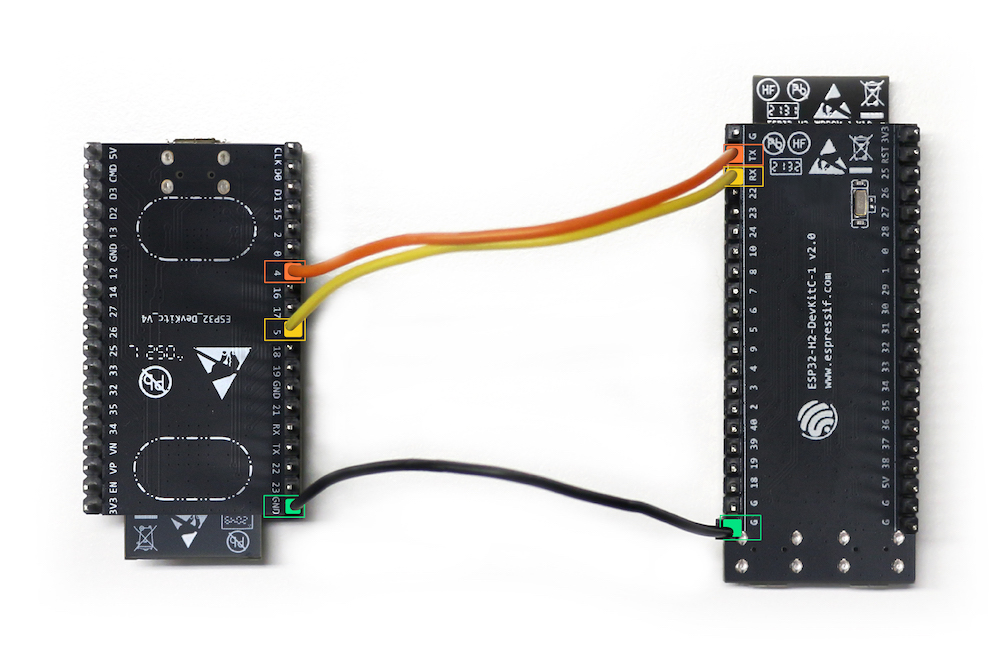| .. | ||
| image | ||
| main | ||
| CMakeLists.txt | ||
| partitions.csv | ||
| README.md | ||
| sdkconfig.defaults | ||
| Supported Targets | ESP32 | ESP32-C3 | ESP32-S2 | ESP32-S3 |
|---|
OpenThread Border Router Example
Overview
This example demonstrates an OpenThread border router.
How to use example
Hardware Required
The following SoCs are required to run this example:
- An ESP32 series Wi-Fi SoC (ESP32, ESP32-C, ESP32-S, etc) loaded with this ot_br example.
- An ESP32-H2 802.15.4 SoC loaded with ot_rcp example.
- Another ESP32-H2 SoC loaded with ot_cli example. Enable
OPENTHREAD_JOINERoption in menuconfig before compiling the example.
Connect the two SoCs via UART, below is an example setup with ESP32 DevKitC and ESP32-H2 DevKitC:

| ESP32 pin | ESP32-H2 pin |
|---|---|
| GND | G |
| GPIO4 | TX |
| GPIO5 | RX |
Configure the project
idf.py menuconfig
Two ways are provided to setup the Thread Border Router in this example:
-
Auto Start Enable
OPENTHREAD_BR_AUTO_START, configure theCONFIG_EXAMPLE_WIFI_SSIDandCONFIG_EXAMPLE_WIFI_PASSWORDwith your access point's ssid and psk. The device will connect to Wi-Fi and form a Thread network automatically after bootup. -
Manual mode Disable
OPENTHREAD_BR_AUTO_STARTand enableOPENTHREAD_CLI_ESP_EXTENSION.wificommand will be added for connecting the device to the Wi-Fi network.
Build, Flash, and Run
Build the project and flash it to the board, then run monitor tool to view serial output:
idf.py -p PORT build flash monitor
If the OPENTHREAD_BR_AUTO_START option is enabled, The device will be connected to the configured Wi-Fi and Thread network automatically then act as the border router.
Otherwise, you need to manually configure the networks with CLI commands.
wifi command can be used to configure the Wi-Fi network.
> wifi
--wifi parameter---
connect
-s : wifi ssid
-p : wifi psk
---example---
join a wifi:
ssid: threadcertAP
psk: threadcertAP : wifi connect -s threadcertAP -p threadcertAP
state : get wifi state, disconnect or connect
---example---
get wifi state : wifi state
Done
To join a Wi-Fi network, please use the wifi connect command:
> wifi connect -s threadcertAP -p threadcertAP
ssid: threadcertAP
psk: threadcertAP
I (11331) wifi:wifi driver task: 3ffd06e4, prio:23, stack:6656, core=0
I (11331) system_api: Base MAC address is not set
I (11331) system_api: read default base MAC address from EFUSE
I (11341) wifi:wifi firmware version: 45c46a4
I (11341) wifi:wifi certification version: v7.0
..........
I (13741) esp_netif_handlers: sta ip: 192.168.3.10, mask: 255.255.255.0, gw: 192.168.3.1
W (13771) wifi:<ba-add>idx:0 (ifx:0, 02:0f:c1:32:3b:2b), tid:0, ssn:2, winSize:64
wifi sta is connected successfully
Done
To get the state of the Wi-Fi network:
> wifi state
connected
Done
For forming the Thread network, please refer to the ot_cli_README.
Example Output
I (2729) esp_netif_handlers: example_connect: sta ip: 192.168.1.100, mask: 255.255.255.0, gw: 192.168.1.1
I (2729) example_connect: Got IPv4 event: Interface "example_connect: sta" address: 192.168.1.100
I (3729) example_connect: Got IPv6 event: Interface "example_connect: sta" address: fe80:0000:0000:0000:266f:28ff:fe80:2920, type: ESP_IP6_ADDR_IS_LINK_LOCAL
I (3729) example_connect: Connected to example_connect: sta
I (3739) example_connect: - IPv4 address: 192.168.1.100
I (3739) example_connect: - IPv6 address: fe80:0000:0000:0000:266f:28ff:fe80:2920, type: ESP_IP6_ADDR_IS_LINK_LOCAL
......
I(8139) OPENTHREAD:[INFO]-MLE-----: AttachState ParentReqReeds -> Idle
I(8139) OPENTHREAD:[NOTE]-MLE-----: Allocate router id 50
I(8139) OPENTHREAD:[NOTE]-MLE-----: RLOC16 fffe -> c800
I(8159) OPENTHREAD:[NOTE]-MLE-----: Role Detached -> Leader
Bidirectional IPv6 connectivity
The border router will automatically publish the prefix and the route table rule to the Wi-Fi network via ICMPv6 router advertisement packages.
Host configuration
The automatically configure your host's route table rules you need to set these sysctl options:
Please replace wlan0 with the real name of your Wi-Fi network interface.
sudo sysctl -w net/ipv6/conf/wlan0/accept_ra=2
sudo sysctl -w net/ipv6/conf/wlan0/accept_ra_rt_info_max_plen=128
For mobile devices, the route table rules will be automatically configured after iOS 14 and Android 8.1.
Testing IPv6 connectivity
Now in the Thread end device, check the IP addresses:
> ipaddr
fde6:75ff:def4:3bc3:9e9e:3ef:4245:28b5
fdde:ad00:beef:0:0:ff:fe00:c402
fdde:ad00:beef:0:ad4a:9a9a:3cd6:e423
fe80:0:0:0:f011:2951:569e:9c4a
You'll notice an IPv6 global prefix with only on address assigned under it. This is the routable address of this Thread node. You can ping this address on your host:
$ ping fde6:75ff:def4:3bc3:9e9e:3ef:4245:28b5
PING fde6:75ff:def4:3bc3:9e9e:3ef:4245:28b5(fde6:75ff:def4:3bc3:9e9e:3ef:4245:28b5) 56 data bytes
64 bytes from fde6:75ff:def4:3bc3:9e9e:3ef:4245:28b5: icmp_seq=1 ttl=63 time=459 ms
64 bytes from fde6:75ff:def4:3bc3:9e9e:3ef:4245:28b5: icmp_seq=2 ttl=63 time=109 ms
64 bytes from fde6:75ff:def4:3bc3:9e9e:3ef:4245:28b5: icmp_seq=3 ttl=63 time=119 ms
64 bytes from fde6:75ff:def4:3bc3:9e9e:3ef:4245:28b5: icmp_seq=4 ttl=63 time=117 ms
Service discovery
The newly introduced service registration protocol(SRP) allows devices in the Thread network to register a service. The border router will forward the service to the Wi-Fi network via mDNS.
Publish the service using SRP
Now we'll publish the service my-service._test._udp with hostname test0 and port 12345
> srp client host name test0
Done
> srp client host address fde6:75ff:def4:3bc3:9e9e:3ef:4245:28b5
Done
> srp client service add my-service _test._udp 12345
Done
> srp client autostart enable
Done
This service will also become visible on the Wi-Fi network:
$ avahi-browse -r _test._udp -t
+ enp1s0 IPv6 my-service _test._udp local
= enp1s0 IPv6 my-service _test._udp local
hostname = [test0.local]
address = [fde6:75ff:def4:3bc3:9e9e:3ef:4245:28b5]
port = [12345]
txt = []
+ enp1s0 IPv4 my-service _test._udp local
= enp1s0 IPv4 my-service _test._udp local
hostname = [test0.local]
address = [fde6:75ff:def4:3bc3:9e9e:3ef:4245:28b5]
port = [12345]
txt = []
Discovery delegate
First, the service testhost._test._udp need to be published using avahi-publish-service on the Wi-Fi network(for example Host).
$ avahi-publish-service testhost _test._udp 12345 test=1 dn="aabbbb"
Then get the border router's OMR prefix global unicast address(or ML-EID), and configure it on the Thread end device.
On the border router:
> ipaddr
fdde:ad00:beef:0:0:ff:fe00:fc10
fd9b:347f:93f7:1:1003:8f00:bcc1:3038
fdde:ad00:beef:0:0:ff:fe00:fc00
fdde:ad00:beef:0:0:ff:fe00:b800
fdde:ad00:beef:0:f891:287:866:776
fe80:0:0:0:77:bca6:6079:785b
Done
On the Thread end device:
> dns config fd9b:347f:93f7:1:1003:8f00:bcc1:3038
(or
> dns config fdde:ad00:beef:0:f891:287:866:776)
Done
Now the service published on the Host can be discovered on the Thread end device.
> dns resolve FA001208.default.service.arpa.
DNS response for FA001208.default.service.arpa. - fdde:ad00:beef:cafe:b939:26be:7516:b87e TTL:120
Done
> dns browse _test._udp.default.service.arpa.
DNS browse response for _test._udp.default.service.arpa.
testhost
Port:5683, Priority:0, Weight:0, TTL:120
Host:FA001208.default.service.arpa.
HostAddress:fdde:ad00:beef:cafe:b939:26be:7516:b87e TTL:120
TXT:[test=31, dn=616162626262] TTL:120
Done
> dns service testhost _test._udp.default.service.arpa.
DNS service resolution response for testhost for service _test._udp.default.service.arpa.
Port:5683, Priority:0, Weight:0, TTL:120
Host:FA001208.default.service.arpa.
HostAddress:fdde:ad00:beef:cafe:b939:26be:7516:b87e TTL:120
TXT:[test=31, dn=616162626262] TTL:120
Done